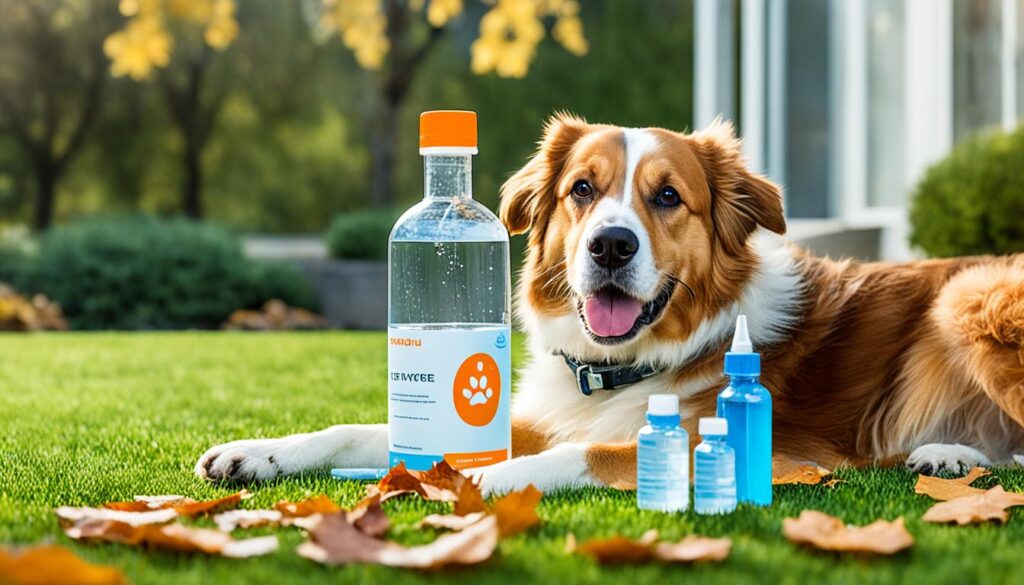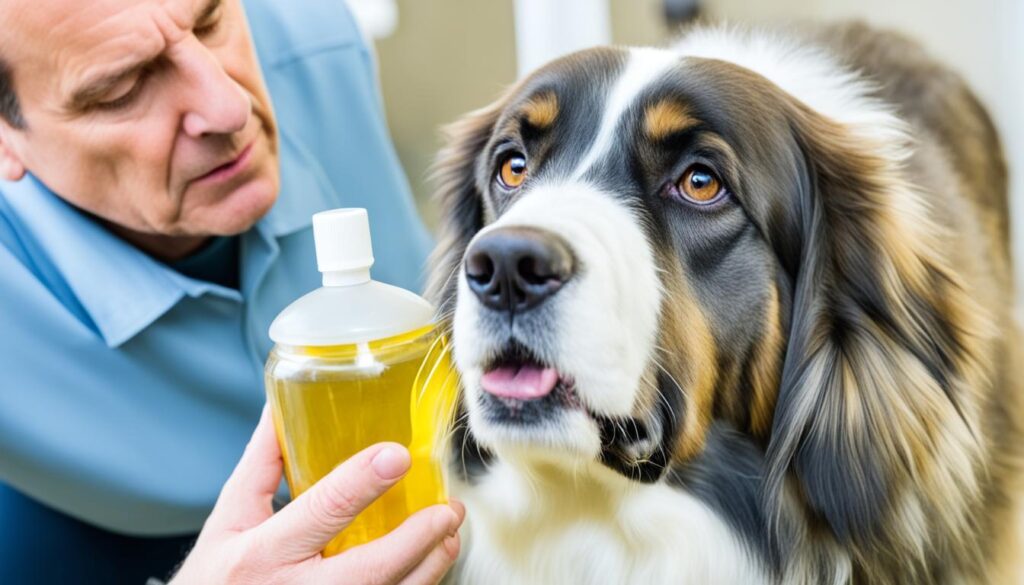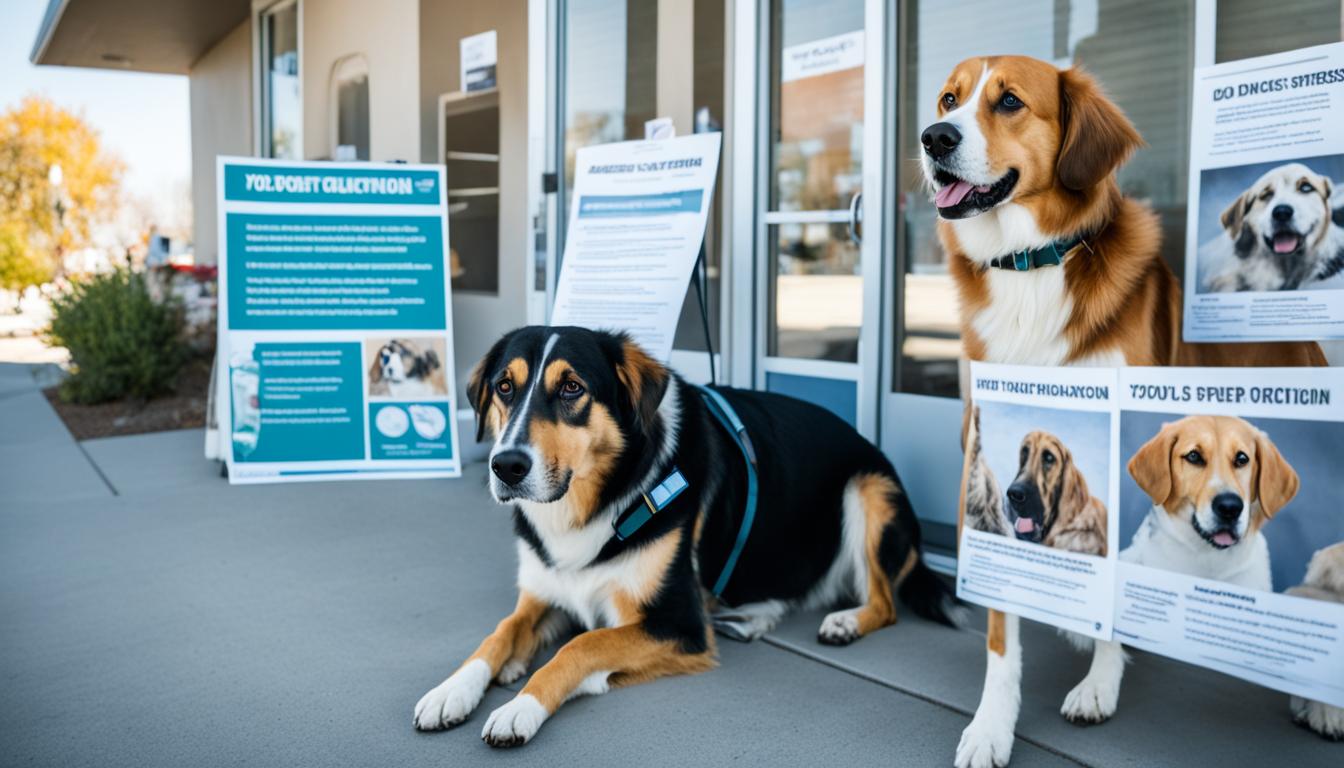As an Amazon Associate I earn from qualifying purchases.
As a dog owner, you want nothing but the best for your furry friend. But have you ever wondered about the most common dog illnesses and how to prevent them? It’s time to put your pet health concerns to rest and equip yourself with the knowledge to keep your pup happy and healthy.
From canine diseases to popular dog ailments, we’ll dive into the prevalent canine conditions that every pet owner should be aware of. So, let’s challenge common beliefs and discover the truth behind popular pet health problems!
Key Takeaways:
- Understanding common dog illnesses is essential for early detection and treatment.
- Parvovirus, Cancer, and Ear Infections are three common dog illnesses we will explore in this article.
- Prevention tips play a vital role in safeguarding your dog’s health.
- Regular veterinary check-ups, vaccinations, proper nutrition, exercise, and hygiene practices are key to preventing common dog illnesses.
- Stay informed and proactive to provide the best care for your beloved companion.
Parvovirus: Highly Contagious and Dangerous
Parvovirus is a highly contagious viral disease that primarily affects unvaccinated dogs and puppies. This menacing virus spreads through contact with infected feces or contaminated environments, making dogs susceptible to infection. If you notice any of the common symptoms of Parvovirus, such as fever, bloody diarrhea, weakness, vomiting, reduced appetite, or dehydration, it’s essential to act swiftly and seek immediate veterinary care.
| Common Symptoms of Parvovirus: |
|---|
| Fever |
| Bloody diarrhea |
| Weakness |
| Vomiting |
| Reduced appetite |
| Dehydration |
Anecdotal evidence suggests that Parvovirus can have devastating consequences if left untreated. It may lead to serious complications, including chronic heart diseases, bone marrow damage, bacterial pneumonia, and even potential fatality. As a responsible pet parent, it’s crucial to prioritize prevention and protect your furry friend from this dangerous virus by ensuring they receive proper vaccinations and booster shots.
Prevention Tips for Parvovirus:
- Keep your dog’s vaccinations up-to-date.
- Avoid contact with infected dogs or contaminated environments.
- Practice good hygiene by regularly cleaning your dog’s living area and eliminating any feces promptly.
- Consult with your veterinarian about the best vaccination schedule and preventive measures.
Remember, proactive measures can go a long way in safeguarding your beloved companion from the perils of Parvovirus.
Image: A visual representation of a concerned dog owner seeking veterinary assistance for a Parvovirus-infected dog.
Cancer: A Growing Concern for Dogs
As a dog owner, it’s important to be aware of the growing concern of cancer in canine companions. With advancements in veterinary care and early detection, many dogs can lead longer lives even in the face of this formidable disease.
There are various types of cancer that can affect dogs, including soft tissue sarcomas, breast cancer, skin cancer, bone cancer, and malignant lymphomas. Each type presents its own set of challenges and symptoms that pet owners should watch out for.
Symptoms of cancer in dogs may include:
- Wounds that don’t heal
- Abnormal bleeding
- Lumps or bumps
- Lameness or swelling in bones
- Enlarged lymph nodes
- And more…
Early detection is crucial for improving the chances of survival. Regular vet check-ups and being observant of any unusual changes in your dog’s health can make a significant difference in catching cancer at its earliest stages.
Some dog breeds may have a higher predisposition to certain types of cancer, such as Golden Retrievers and their increased risk of developing lymphoma. Additionally, environmental factors can also play a role in cancer development.
Spaying and neutering at a young age can help reduce the risk of certain types of cancer in dogs. This preventive measure can be an effective strategy to protect your furry companion against potential health issues down the line.
Remember, early detection, proactive veterinary care, and a watchful eye can make a world of difference when it comes to cancer in dogs.
Ear Infections: Common and Treatable
Ear infections are a pesky health issue that can leave your furry friend feeling uncomfortable. But fret not, because they are also highly treatable! Whether your dog is prone to ear infections or experiencing one for the first time, understanding the symptoms and seeking proper treatment is essential for their well-being.
What causes ear infections in dogs?
Canine ear infections can be caused by a variety of factors, including:
- Allergies
- Autoimmune disorders
- Wax buildup
- Moisture in the ears
These factors create the perfect environment for bacteria or yeast to thrive in your dog’s ears, leading to infection.
What are the symptoms of ear infections in dogs?
It’s important to keep an eye out for the following symptoms, as they may indicate an ear infection:
- Itchiness
- Pain or discomfort
- Odor
- Dark discharge
- Scabs or crusts
- Swelling and redness in the ear canal
If you notice any of these symptoms, it’s time to schedule a visit to the vet.
Treatment for ear infections in dogs
“A stitch in time saves nine!” The same holds true when it comes to treating ear infections in dogs. Prompt veterinary treatment is crucial to prevent the infection from worsening. Treatment may include:
- Thorough cleaning of the ears
- Medication, such as antibiotics or antifungal drugs
- In some cases, your vet may recommend ear drops or ointments to help soothe and heal the infection
Remember to follow your veterinarian’s instructions carefully and complete the full course of medication to ensure the infection is completely eradicated.
Prevention is key! Regular ear cleaning and proper care can help minimize the likelihood of your furry companion developing ear infections. Your vet can provide guidance on the best cleaning methods and products to use. Maintaining good ear hygiene is especially important for dogs with long, floppy ears or those prone to allergies.
| Treatment for Ear Infections in Dogs | Pros | Cons |
|---|---|---|
| Thorough cleaning of the ears | – Removes debris and promotes healing – Provides immediate relief |
– Can be challenging if your dog is resistant or anxious – In some cases, cleaning alone may not be sufficient |
| Medication (antibiotics or antifungal drugs) | – Targets and eliminates the infection – Helps prevent recurrence |
– Potential side effects – May require multiple doses |
| Ear drops or ointments | – Soothes discomfort – Aids in healing the infection |
– Application can be tricky – Requires consistent use |
“Clean ears, happy pup!”
Dental Disease: A Silent Enemy
As your furry friend ages, dental disease can become a common health issue in dogs. Tartar, gingivitis, and periodontal diseases are the most frequently encountered oral problems dogs face. Keep an eye out for symptoms such as bad breath, loose teeth, changes in appetite, blood or pus discharge from the mouth, drooling, lumps on the gums, and discolored teeth and gums. These indicators are red flags that your dog may be suffering from dental disease.
To prevent and treat dental disease in dogs, regular dental care is essential. This includes teeth cleaning, extractions, and maintaining proper oral hygiene. Don’t neglect your dog’s dental health! Schedule regular veterinary visits and consider professional grooming to help keep their oral health in check.
Did you know that dental disease can lead to more serious health issues if left untreated? Taking care of your dog’s teeth is crucial for their overall well-being.
Causes and Effects
Dental disease in dogs is primarily caused by the buildup of plaque and tartar on their teeth. If not properly addressed, this can lead to gum inflammation (gingivitis) and eventually progress to periodontal disease, which involves damage to the gums, bones, and teeth supporting structures.
This silent enemy not only affects your dog’s oral health but can also lead to more severe health problems such as heart disease, kidney disease, and infection in other parts of the body due to bacteria from the mouth entering the bloodstream.
The Dental Disease Treatment Process
When it comes to treating dental disease in dogs, there are several options available depending on the severity of the condition. Your veterinarian may recommend:
- Professional dental cleaning under anesthesia to remove tartar and plaque buildup
- Extractions of severely affected teeth
- Antibiotics to eliminate infection
- Pain medication to alleviate discomfort
Each dog’s treatment plan will vary based on their specific needs and the extent of the dental disease. Your veterinarian will guide you through the process and ensure your dog receives the appropriate treatment.
Prevention Tips
Preventing dental disease in dogs is key to maintaining their overall health. Here are some tips to help you keep your furry friend’s teeth in great shape:
- Regular teeth brushing with a dog-specific toothbrush and toothpaste
- Providing dental-friendly chew toys or dental treats
- Incorporating dry kibble into their diet for mechanical cleaning
Remember, prevention is always better than cure! By prioritizing your dog’s dental health, you can help them avoid the discomfort and potential complications associated with dental disease.
| Dental Disease Prevention Tips | Dental Disease Treatment Options |
|---|---|
|
|
Take action and ensure your dog’s dental health remains impeccable! By following these preventive measures and seeking appropriate treatment, you can help your furry companion maintain a healthy and happy smile.
Itchy Skin and Skin Infections: Finding Relief
If you’ve noticed your furry friend constantly scratching, losing hair, or experiencing redness on their skin, itchy skin and skin infections may be the culprit. These common problems in dogs can be caused by allergies, bacterial infections, or yeast infections.
Excessive scratching can lead to the development of hot spots, which are painful and inflamed areas on your dog’s skin. Identifying and addressing the underlying cause of their itchy skin, such as food allergies or environmental triggers, is crucial for providing relief.
When it comes to treating itchy skin in dogs, there are various options available:
- Dietary Changes: Switching your dog to a hypoallergenic or limited ingredient diet can help eliminate food allergies as a potential cause of their skin issues.
- Medicated Shampoos: Using specially formulated shampoos can help soothe your dog’s itchy skin and reduce inflammation. Look for shampoos that contain ingredients like oatmeal or aloe vera.
- Topical Ointments: Applying medicated creams or ointments can provide relief for localized areas of itchy skin. Consult your veterinarian for appropriate recommendations.
- Antibiotics: If your dog’s skin infection is bacterial in nature, your veterinarian may prescribe antibiotics to treat the underlying infection.
“Relief is just a few steps away! By addressing the underlying cause and utilizing the right treatments, you can help your beloved companion find comfort and relief from itchy skin.”
Regular grooming and maintaining good hygiene practices are also essential for preventing skin issues in dogs. This includes bathing them regularly with dog-friendly products and ensuring their coat is free from dirt, debris, and parasites.
Common Causes of Itchy Skin in Dogs
| Cause | Description |
|---|---|
| Allergies | Dogs can be allergic to certain foods, environmental factors like pollen or dust mites, or even fleas. |
| Bacterial Infections | Bacteria can infect a dog’s skin, leading to itching, redness, and discomfort. |
| Yeast Infections | Yeast overgrowth can cause itchy, inflamed skin, especially in areas with folds or moisture. |
Vomiting and Diarrhea: Signs of Digestive Upset
Oh no, it’s a dreadful sight to witness your beloved furry friend experiencing digestive distress. From unexpected vomit splatters to messy diarrhea explosions, these unpleasant symptoms can be worrisome for any pet parent. But fear not, for you shall be armed with knowledge to combat these common digestive issues that can plague our four-legged companions.
When it comes to dog digestion, a few factors can lead to bouts of vomiting and diarrhea. It could be caused by your pooch’s notorious knack for gobbling down anything they find, from last night’s leftovers to unidentified objects they discovered during their adventurous stroll in the park. Infections, both bacterial and viral, can also wreak havoc on your dog’s tummy. And let’s not forget about those pesky intestinal parasites that can turn your pup’s digestive system into their personal playground.
While the occasional episode of vomiting or diarrhea may not be cause for immediate concern, persistent or recurrent symptoms should be evaluated by a trusted veterinarian. Why? Because sometimes these symptoms can point to underlying health issues that require professional attention.
But what can you do to help your furry friend feel better? The treatment options for vomiting and diarrhea in dogs vary depending on the root cause. For instance, if infections or parasites are the culprits, medications to address these issues may be necessary. Dietary changes can also play a vital role in managing digestive upset. Your vet may recommend a temporary shift to a bland diet or a specific prescription diet to aid in the recovery process.
It is essential to provide your dog with supportive care to prevent dehydration, which can occur due to the loss of fluids from vomiting and diarrhea. Encouraging them to drink water or offering ice cubes can help replenish their fluids.
A healthy digestive system begins with proper nutrition and regular exercise. Ensuring your furry friend has a balanced diet and maintaining their ideal weight will go a long way in supporting their digestive health. Additionally, regular exercise helps keep their gastrointestinal tract in excellent working order.
The Power of Probiotics
One popular method for promoting digestive health in dogs is the incorporation of probiotics into their daily routine. Probiotics are beneficial bacteria that help maintain a healthy gut environment and aid in digestion. Just like humans, dogs can benefit from these friendly microorganisms. However, it’s crucial to consult with your veterinarian to determine the most suitable probiotic supplement for your furry friend’s specific needs.
“Just a spoonful of probiotics helps the tummy troubles go down!” – Mary Puppins
When it comes to your dog’s overall well-being, it’s essential to prioritize their digestive health. By addressing vomiting and diarrhea promptly, you can help your furry friend feel better and prevent any potential complications. Remember, a healthy diet, regular exercise, and the occasional dose of probiotics can be the secret ingredients to keeping your pup’s tummy happy and his tail wagging with joy.

Stiffness and Pain: Managing Joint Health
As your furry companion ages, stiffness and joint pain can become common issues that affect their mobility and quality of life. It’s important to prioritize their joint health, ensuring they remain active and comfortable. By addressing these issues early on, you can help your dog maintain their vitality and happiness for years to come.
Symptoms of Joint Pain in Dogs
It’s crucial to recognize the signs of joint pain in your dog. Some common symptoms include:
- Limping or favoring certain limbs
- Difficulty climbing stairs or jumping
- Reluctance to exercise or play
- Stiffness and difficulty getting up after resting
- Noticeable changes in gait or movement
If you observe any of these symptoms, it’s important to consult with your veterinarian for appropriate diagnosis and treatment options.
Treatment for Joint Stiffness in Dogs
Fortunately, there are several treatment options available to manage joint stiffness and pain in dogs. Some key approaches include:
- Weight management: Maintaining a healthy weight is crucial for reducing stress on the joints. Consult your veterinarian for guidance on appropriate portion sizes and diet choices.
- Joint supplements: Incorporating joint supplements, such as glucosamine and chondroitin, can help support joint health and reduce inflammation. These supplements can be easily administered as treats or added to your dog’s food.
- Regular exercise: Providing regular low-impact exercise tailored to your dog’s needs can help strengthen muscles and improve joint function. Be sure to consult with your veterinarian to determine the appropriate exercise regimen.
- Dietary adjustments: A balanced and nutritious diet can contribute to overall joint health. Consider incorporating foods rich in omega-3 fatty acids, antioxidants, and other joint-supporting nutrients.
- Comfortable sleeping areas: Providing your dog with a cozy and supportive bed can alleviate joint pressure and promote better rest.
Remember, always consult with your veterinarian before starting any new treatments or medications for your dog.
Comparison of Joint Supplements
| Joint Supplement | Benefits | Dosage | Form |
|---|---|---|---|
| Glucosamine | Supports joint cartilage, reduces inflammation | Varies by weight and severity of condition | Chewable tablets, liquid, powder |
| Chondroitin | Helps maintain joint flexibility, reduces pain | Varies by weight and severity of condition | Chewable tablets, capsules, powder |
| Omega-3 Fatty Acids | Reduces joint inflammation, improves mobility | Varies by weight and severity of condition | Liquid, capsules |
Consult with your veterinarian to determine the most suitable joint supplement for your dog, keeping in mind their specific needs and condition.
By implementing these strategies and seeking professional guidance, you can help alleviate joint stiffness and pain in your beloved canine companion, ensuring they live a happy and active life.
Urinary Tract Problems: Addressing Common Issues
Urinary tract problems can give your furry friend a real ruff time! From urinary tract infections to bladder stones, canine urinary tract issues can be a major pain in the tail. So, let’s sniff out the symptoms, possible causes, and treatment options for these pesky problems.
Recognizing the Symptoms
When your dog is experiencing urinary tract problems, they might start behaving quite paw-sitively unusual. Keep an eye out for these telltale signs:
- Frequent urination: If your dog suddenly needs to go outside more often than usual, it could be a sign of a urinary tract issue.
- Accidents in the house: If your well-trained pup is having accidents indoors, it could be due to bladder discomfort.
- Blood in the urine: Seeing red flags in your dog’s urine is a clear indication that something’s not quite right.
- Discomfort while urinating: Your dog may show signs of pain or discomfort while peeing.
Exploring the Causes
There are several factors that can contribute to urinary tract problems in dogs. Bacterial infections, bladder stones, and other underlying conditions can all play a paw-t in causing these issues. It’s important to consult your veterinarian to determine the underlying cause of your dog’s urinary tract problems.
Fetching Treatment Options
When it comes to treating urinary tract problems in dogs, the goal is to get your pup back to wagging their tail in no time! Treatment options may include:
- Antibiotics: If a bacterial infection is the culprit, antibiotics can help eliminate the infection and relieve symptoms.
- Dietary changes: Your vet may recommend a specialized diet to prevent the formation of bladder stones or manage underlying conditions.
- Managing underlying conditions: If urinary tract problems are caused by an underlying condition, such as diabetes or hormonal imbalance, additional treatment may be necessary.
Prevention is the Best Medicine
Just like hoomans, prevention is key when it comes to urinary tract problems in dogs. Here’s how you can help keep your pup’s plumbing in tip-top shape:
- Provide fresh water: Ensure your dog always has access to clean, fresh water to encourage regular hydration and flushing of the urinary tract.
- Regular bathroom breaks: Take your dog out for bathroom breaks frequently to prevent waste build-up and reduce the risk of infection.
- Maintain good hygiene: Proper grooming, including keeping the genital area clean, can help prevent urinary tract issues.
Remember, when it comes to urinary tract problems in dogs, the best thing you can do is to seek veterinary care promptly. Your furry friend will thank you for it!

Conclusion
As a responsible dog owner, it is crucial to be aware of common dog illnesses, understand their symptoms, and take preventive measures to ensure your furry companion’s health and well-being. Regular veterinary check-ups, timely vaccinations, proper nutrition, regular exercise, and good hygiene practices are key to preventing and managing many common dog illnesses.
By staying informed and proactive, you can provide the best care for your dog and help them live a happy, healthy life. Remember, if you notice any signs of illness in your dog, don’t hesitate to seek professional veterinary care. Early detection and prompt treatment can make a significant difference in their recovery.
Keep an eye out for common dog health concerns such as Parvovirus, Cancer, Ear Infections, Dental Disease, Itchy Skin and Skin Infections, Vomiting and Diarrhea, Joint Stiffness and Pain, and Urinary Tract Problems. By implementing preventive measures, such as regular vaccinations and proper hygiene, you can minimize the risk of these illnesses and ensure your dog’s well-being.
Take care of your beloved four-legged friend by providing them with the love, care, and attention they deserve. They bring joy and happiness to our lives, and it’s our responsibility to keep them healthy and protected from common dog illnesses.
FAQ
What is Parvovirus?
What are the symptoms of Parvovirus?
How can Parvovirus be prevented?
What types of cancer can affect dogs?
What are the symptoms of cancer in dogs?
Can spaying and neutering reduce the risk of cancer in dogs?
What are the common causes of ear infections in dogs?
What are the symptoms of ear infections in dogs?
How can ear infections in dogs be treated?
What are the common symptoms of dental disease in dogs?
How can dental disease be prevented in dogs?
What are the common causes of itchy skin and skin infections in dogs?
How can itchy skin in dogs be treated?
What are the common causes of vomiting and diarrhea in dogs?
When should I seek veterinary care for my dog’s vomiting and diarrhea?
How can joint stiffness and pain in dogs be managed?
How can urinary tract problems in dogs be treated?
How can I prevent common dog illnesses?
Source Links
- https://www.aspca.org/pet-care/dog-care/common-dog-diseases
- https://www.guilfordjamestownvet.com/site/blog-greensboro-vet/2020/04/09/common-dog-illnesses-symptoms
- https://www.petresort.com/medical/most-common-dog-illnesses-symptoms-treatment/
As an Amazon Associate I earn from qualifying purchases.

